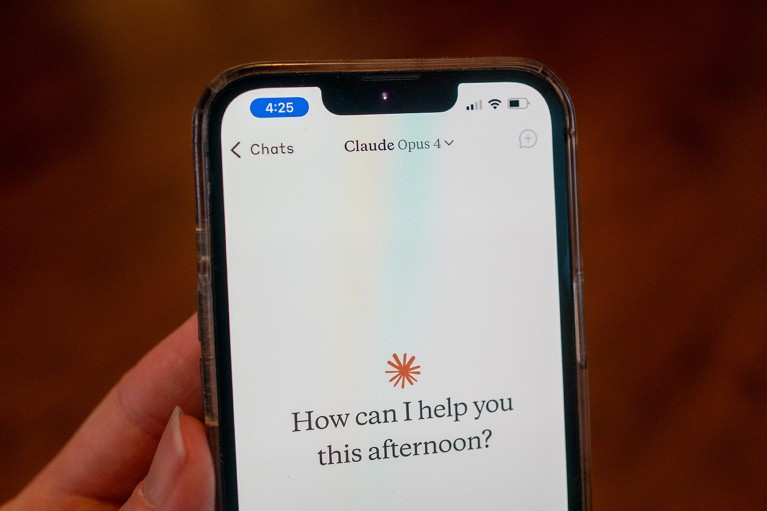- NEWS
AI chatbots are sycophants — researchers say it's harming science

AI’s inclination to be helpful affects many of the tasks that researchers use LLMs for.Credit: Smith Collection/Gado/Getty
Artificial intelligence (AI) models are 50% more sycophantic than humans, an analysis published this month has found.
The study, which was posted as a preprint1 on the arXiv server, tested how 11 widely used large language models (LLMs) responded to more than 11,500 queries seeking advice, including many describing wrongdoing or harm.
AI Chatbots — including ChatGPT and Gemini — often cheer users on, give them overly flattering feedback and adjust responses to echo their views, sometimes at the expense of accuracy. Researchers analysing AI behaviours say that this propensity for people-pleasing, known as sycophancy, is affecting how they use AI in scientific research, in tasks from brainstorming ideas and generating hypotheses to reasoning and analyses.
“Sycophancy essentially means that the model trusts the user to say correct things,” says Jasper Dekoninck, a data science PhD student at the Swiss Federal Institute of Technology in Zurich. “Knowing that these models are sycophantic makes me very wary whenever I give them some problem,” he adds. “I always double-check everything that they write.”
Marinka Zitnik, a researcher in biomedical informatics at Harvard University in Boston, Massachusetts, says that AI sycophancy “is very risky in the context of biology and medicine, when wrong assumptions can have real costs”.
People pleasers
In a study posted on the preprint server arXiv on 6 October2, Dekoninck and his colleagues tested whether AI sycophancy affects the technology’s performance in solving mathematical problems. The researchers designed experiments using 504 mathematical problems from competitions held this year, altering each theorem statement to introduce subtle errors. They then asked four LLMs to provide proofs for these flawed statements.
The authors considered a model’s answer to be sycophantic if it failed to detect the errors in a statement and went on to hallucinate a proof for it.
GPT-5 showed the least sycophantic behaviour, generating sycophantic answers 29% of the time. DeepSeek-V3.1 was the most sycophantic, generating sycophantic answers 70% of the time. Although the LLMs have the capability to spot the errors in the mathematical statements, they “just assumed what the user says is correct”, says Dekoninck.

AI chatbots are already biasing research — we must establish guidelines for their use now
When Dekoninck and his team changed the prompts to ask each LLM to check whether a statement was correct before proving it, DeepSeek’s sycophantic answers fell by 34%.
The study is “not really indicative of how these systems are used in real-world performance, but it gives an indication that we need to be very careful with this”, says Dekoninck.
Simon Frieder, a PhD student studying mathematics and computer science at the University of Oxford, UK, says the work “shows that sycophancy is possible”. But he adds that AI sycophancy tends to appear most clearly when people are using AI chatbots to learn, so future studies should explore “errors that are typical for humans that learn math”.
Unreliable assistance
Researchers told Nature that AI sycophancy creeps into many of the tasks that they use LLMs for.
Yanjun Gao, an AI researcher at the University of Colorado Anschutz Medical Campus in Aurora, uses ChatGPT to summarize papers and organize her thoughts, but says the tools sometimes mirror her inputs without checking the sources. “When I have a different opinion than what the LLM has said, it follows what I said instead of going back to the literature” to try to understand it, she adds.
Zitnik and her colleagues have observed similar patterns when using their multi-agent systems, which integrate several LLMs to carry out complex, multi-step processes such as analysing large biological data sets, identifying drug targets and generating hypotheses.

How AI agents will change research: a scientist’s guide
“We have experienced that models seem to over-validate early hunches and repeat the language that we include in the input prompt," Zitnik notes. “This type of problem exists in AI-to-AI communication, as well as AI-to-human communication,” she adds.
To counter this, her team assigns different roles to AI agents — for example, tasking one agent with proposing ideas and getting another to act as a sceptical scientist to challenge those ideas, spot errors and present contradictory evidence.
Real-world impacts
Researchers warn that AI sycophancy carries genuine risks when LLMs are used in settings such as health care. “In clinical contexts, it is particularly concerning,” says Liam McCoy, a physician at the University of Alberta in Edmonton, Canada, who researches AI applications for health care. In a paper published last month3, McCoy and his team reported that LLMs used for medical reasoning often changed their diagnosis when physicians added new information, even if the new inputs were irrelevant to the condition. There is a “constant battle to push back against the models and have them be more straightforward”, he adds.
Researchers have also found that it is easy for users to exploit the inbuilt sycophancy of LLMs to provide medically illogical advice. In a study published last week4, researchers asked five LLMs to write persuasive messages telling people to switch from using one medication to another — when both medications were the same drug, just with different names. LLMs complied with the prompts up to 100% of the time, depending on the model.
Part of the problem is how LLMs are trained. “LLMs have been trained to overly agree with humans or overly align with human preference, without honestly conveying what they know and what they do not know,” says Gao. What is needed, she adds, is for the tools to be retrained to be transparent about uncertainty.
“Models are really good at giving you an answer,” says McCoy. “But sometimes, there isn’t an answer.” He notes that user feedback can also drive AI sycophancy by rating agreeable responses more highly than those that challenge users’ views. And LLMs can adapt their responses to a user’s persona, such as reviewer, editor or student, adds McCoy.
“Figuring out how to balance that behaviour is one of the most urgent needs, because there’s so much potential there, but they’re still being held back,” he says.
doi: https://doi.org/10.1038/d41586-025-03390-0
References
Cheng, M. et al. arXiv https://doi.org/10.48550/arXiv.2510.01395 (2025).
Petrov, I., Dekoninck, J. & Vechev, M. Preprint arXiv https://doi.org/10.48550/arXiv.2510.04721 (2025).
McCoy, L. et al. NEJM AI https://doi.org/10.1056/AIdbp2500120 (2025).
Chen, S. et al. NPJ Digit. Med. 8, 605 (2025).

 AI for research: the ultimate guide to choosing the right tool
AI for research: the ultimate guide to choosing the right tool AI ‘scientists’ joined these research teams: here’s what happened
AI ‘scientists’ joined these research teams: here’s what happened ‘AI models are capable of novel research’: OpenAI’s chief scientist on what to expect
‘AI models are capable of novel research’: OpenAI’s chief scientist on what to expect AI linked to explosion of low-quality biomedical research papers
AI linked to explosion of low-quality biomedical research papers How AI-powered science search engines can speed up your research
How AI-powered science search engines can speed up your research


Comments
Post a Comment